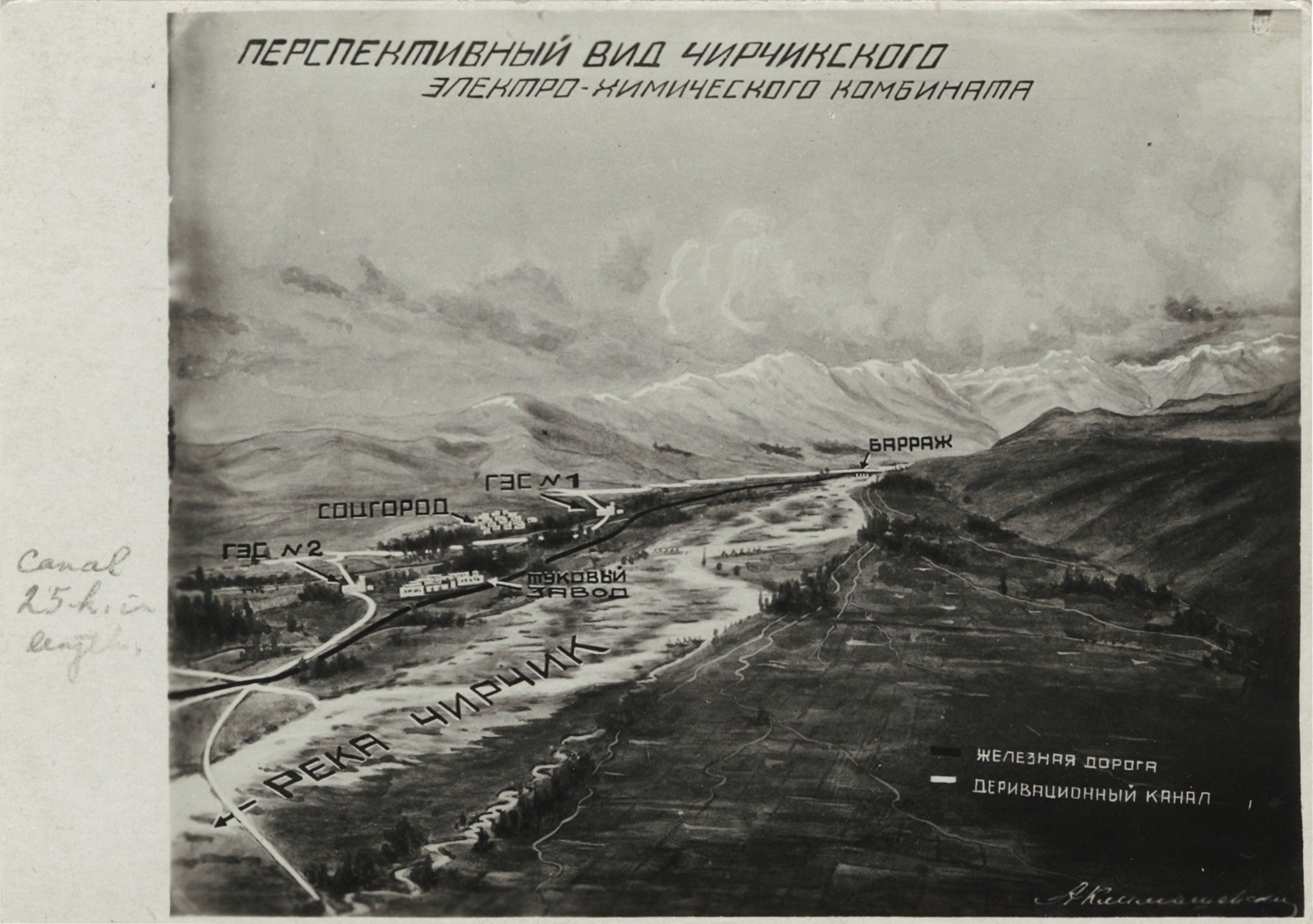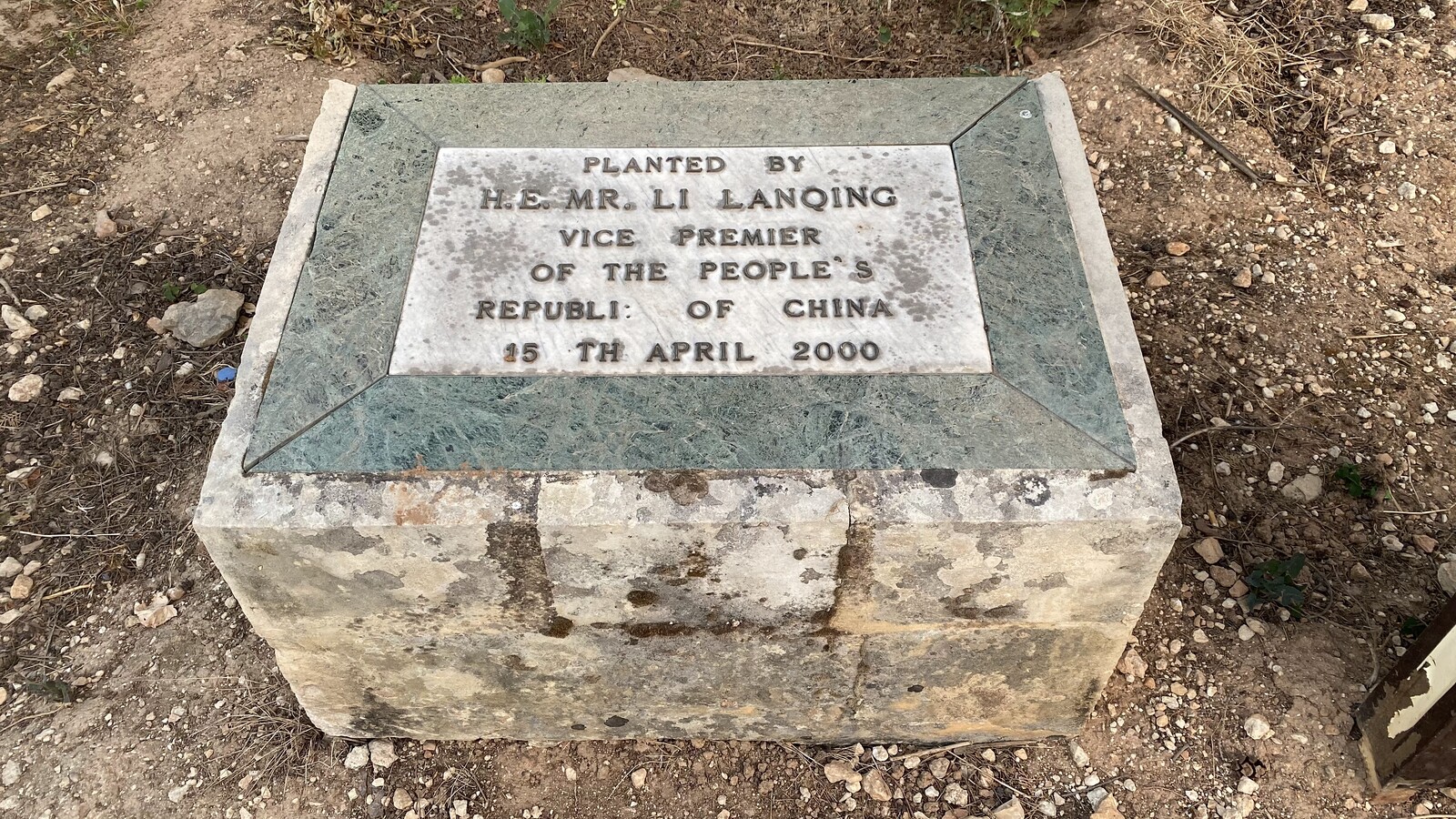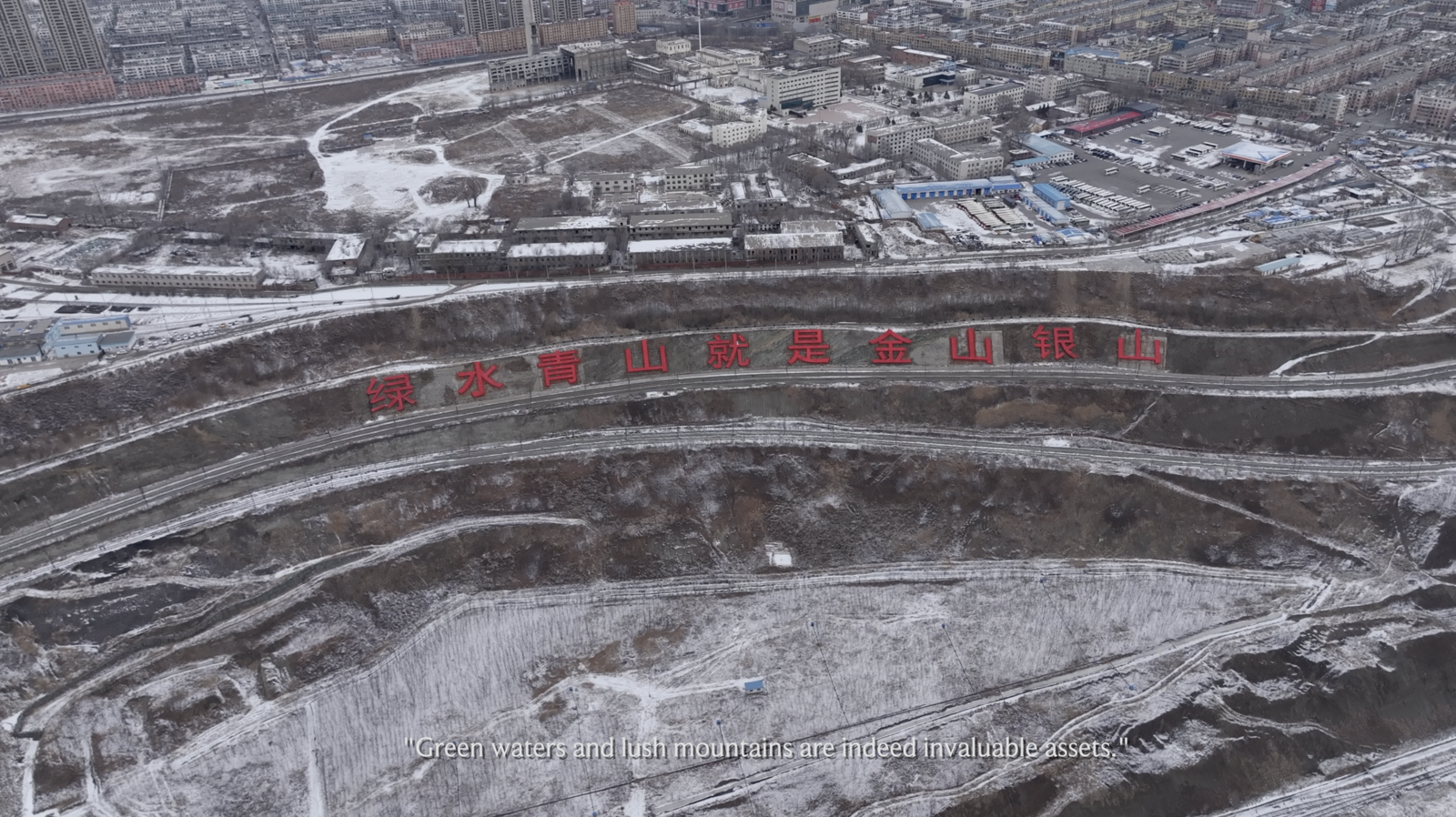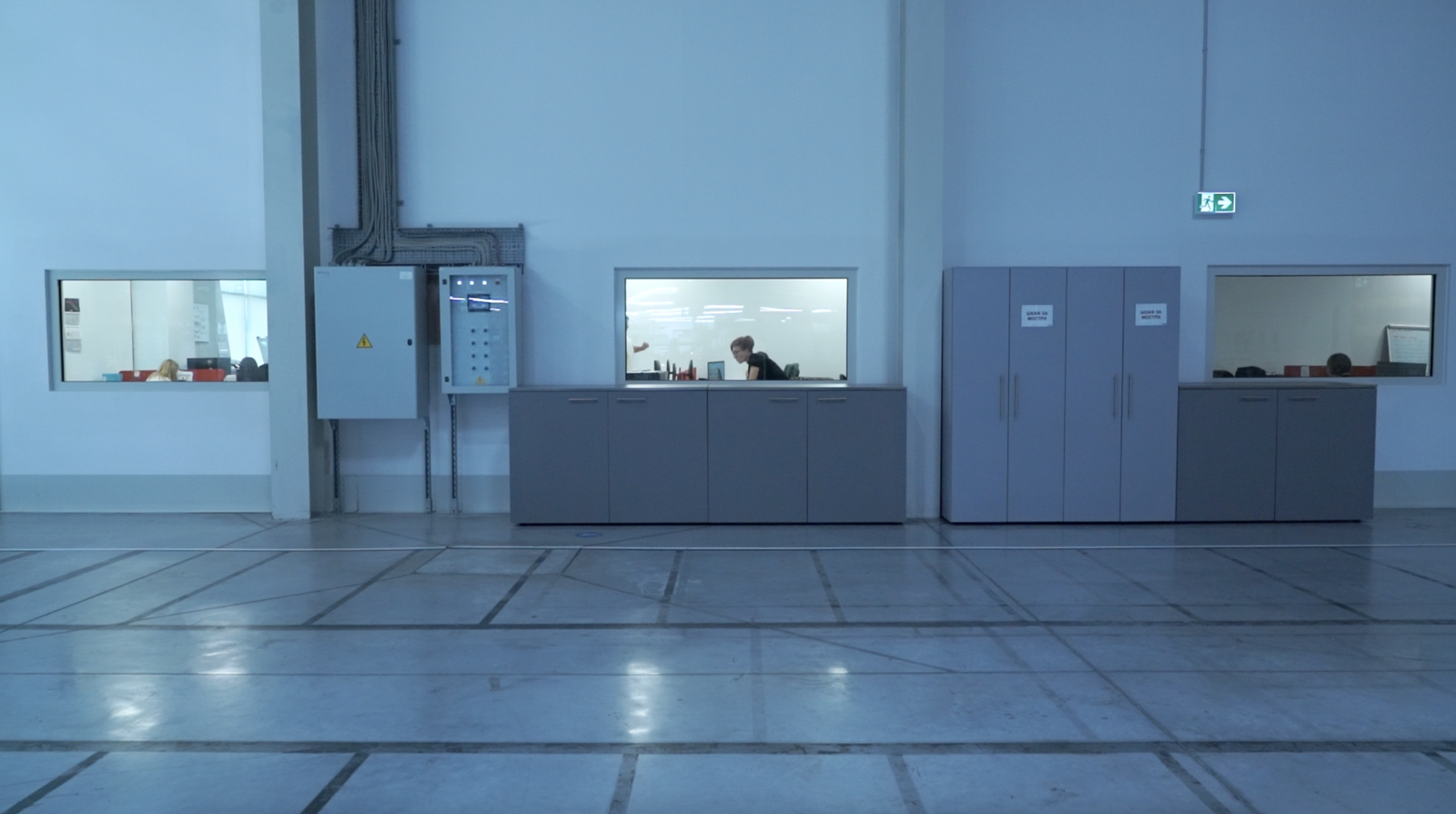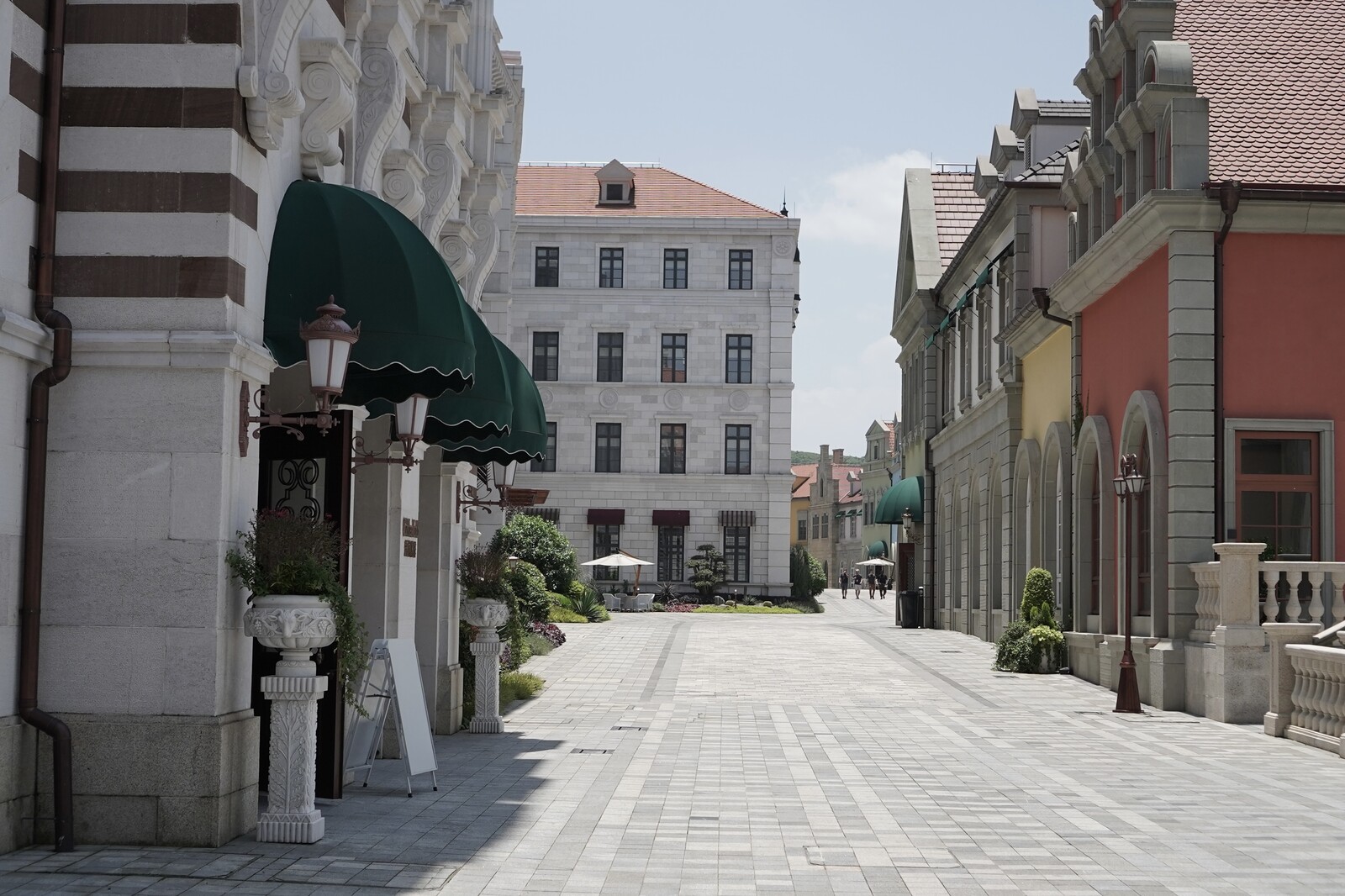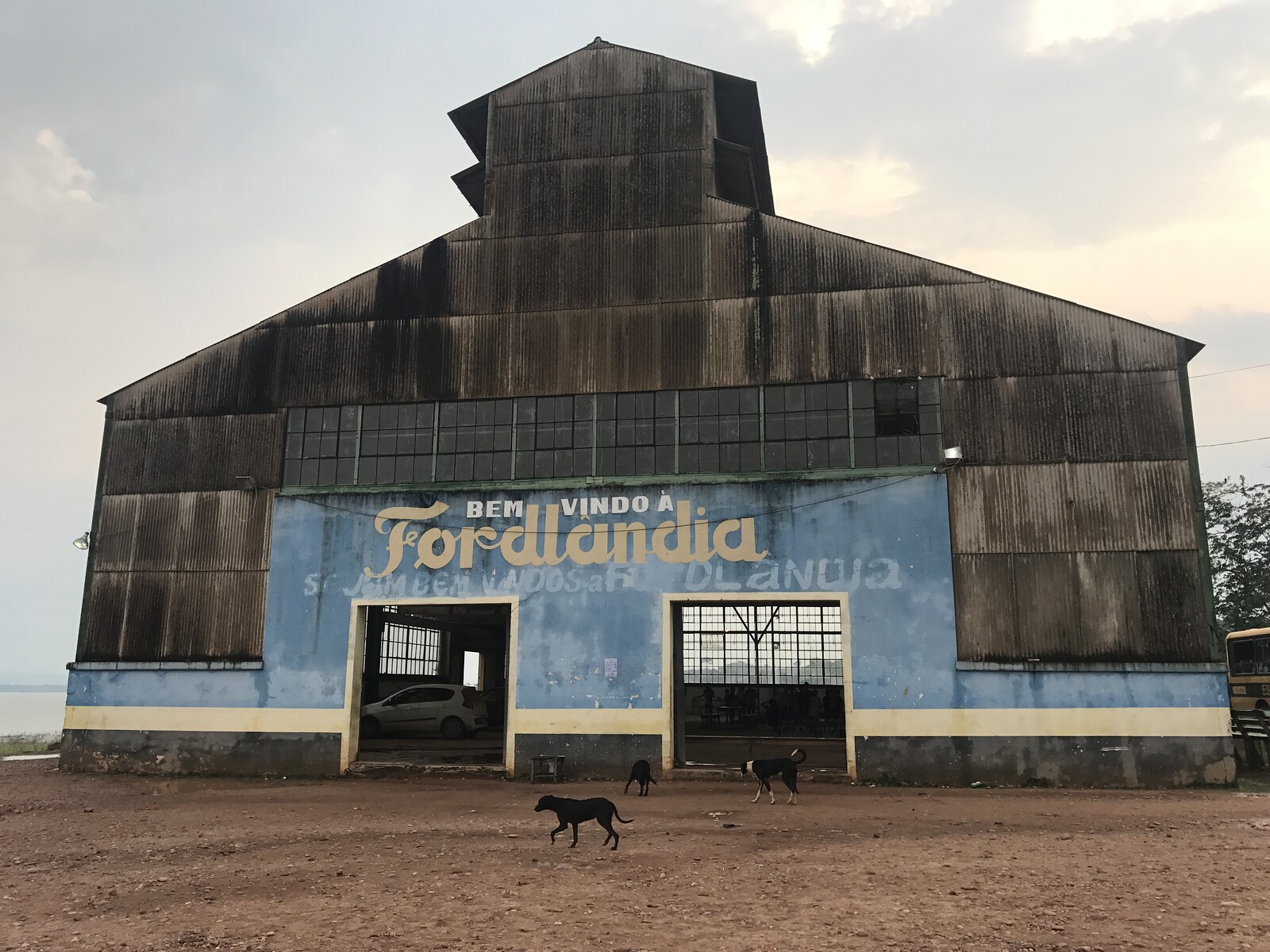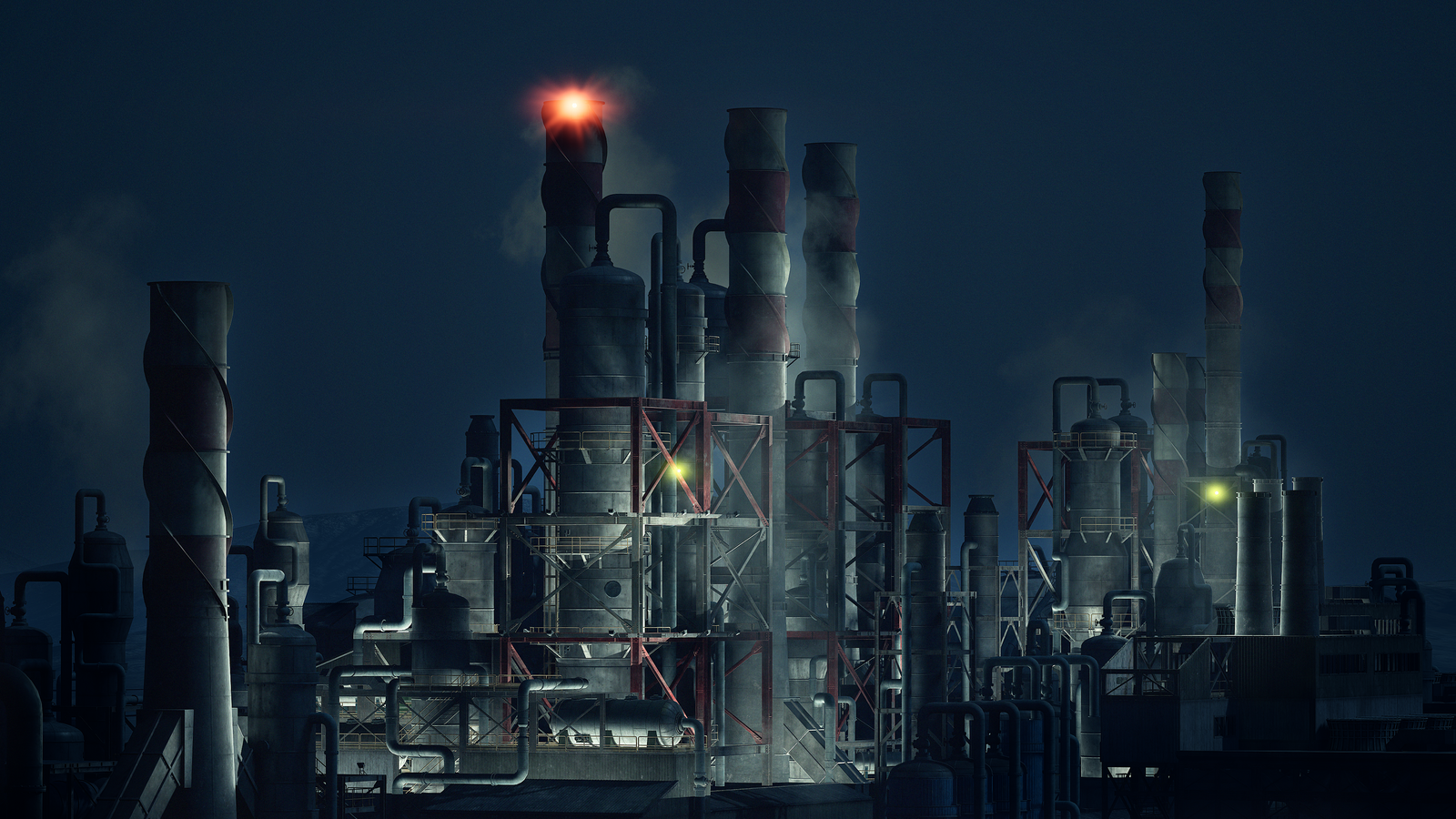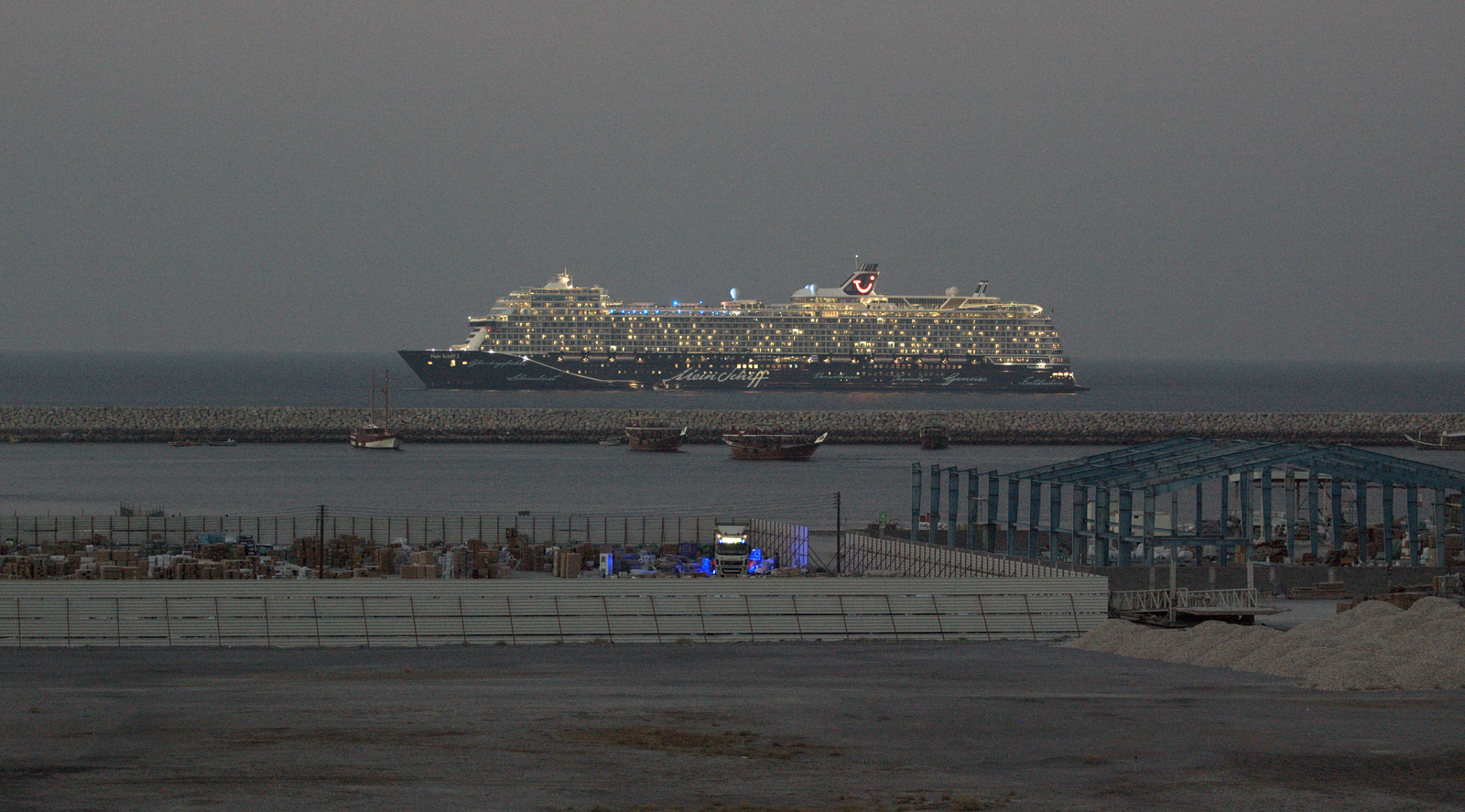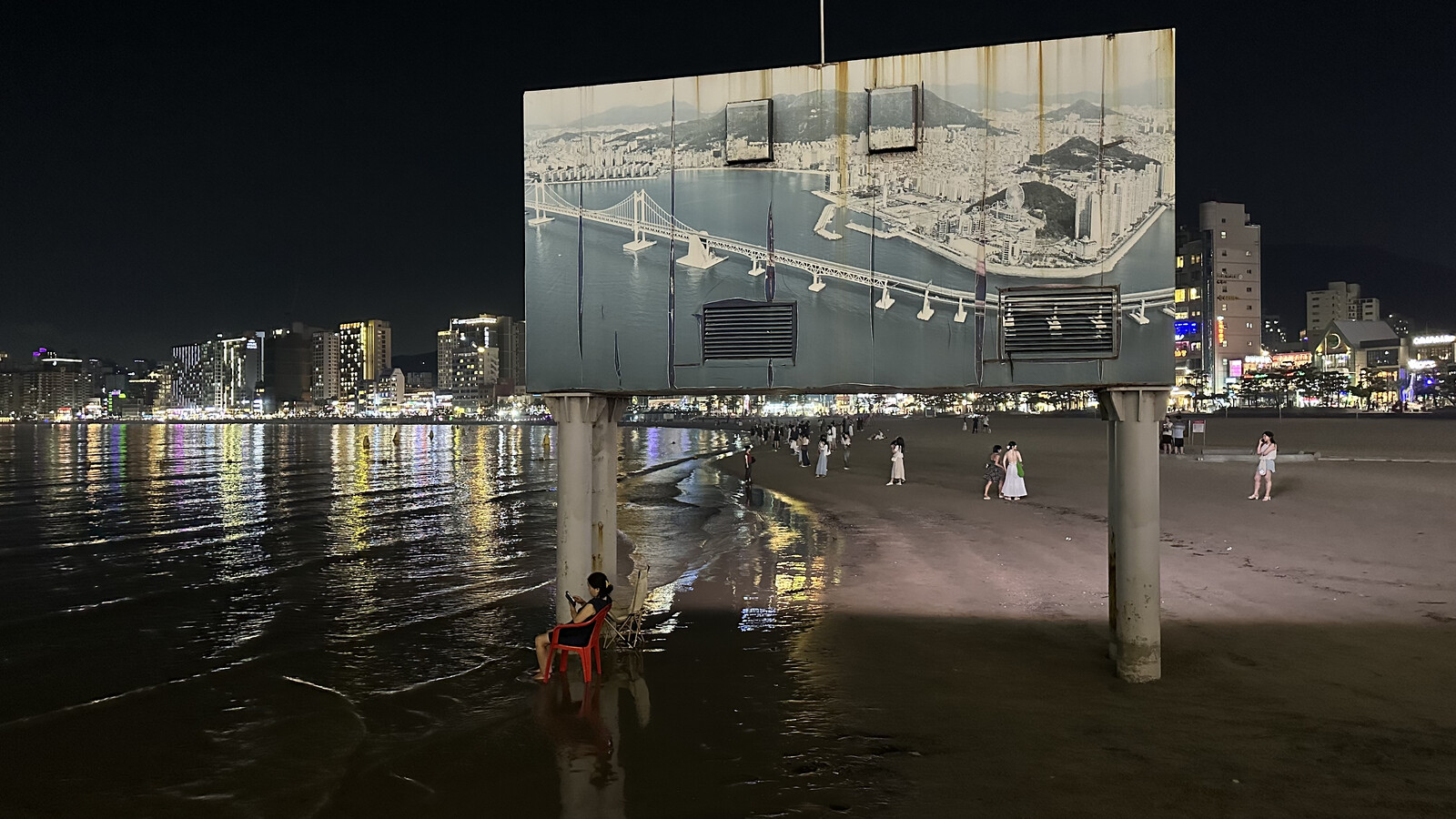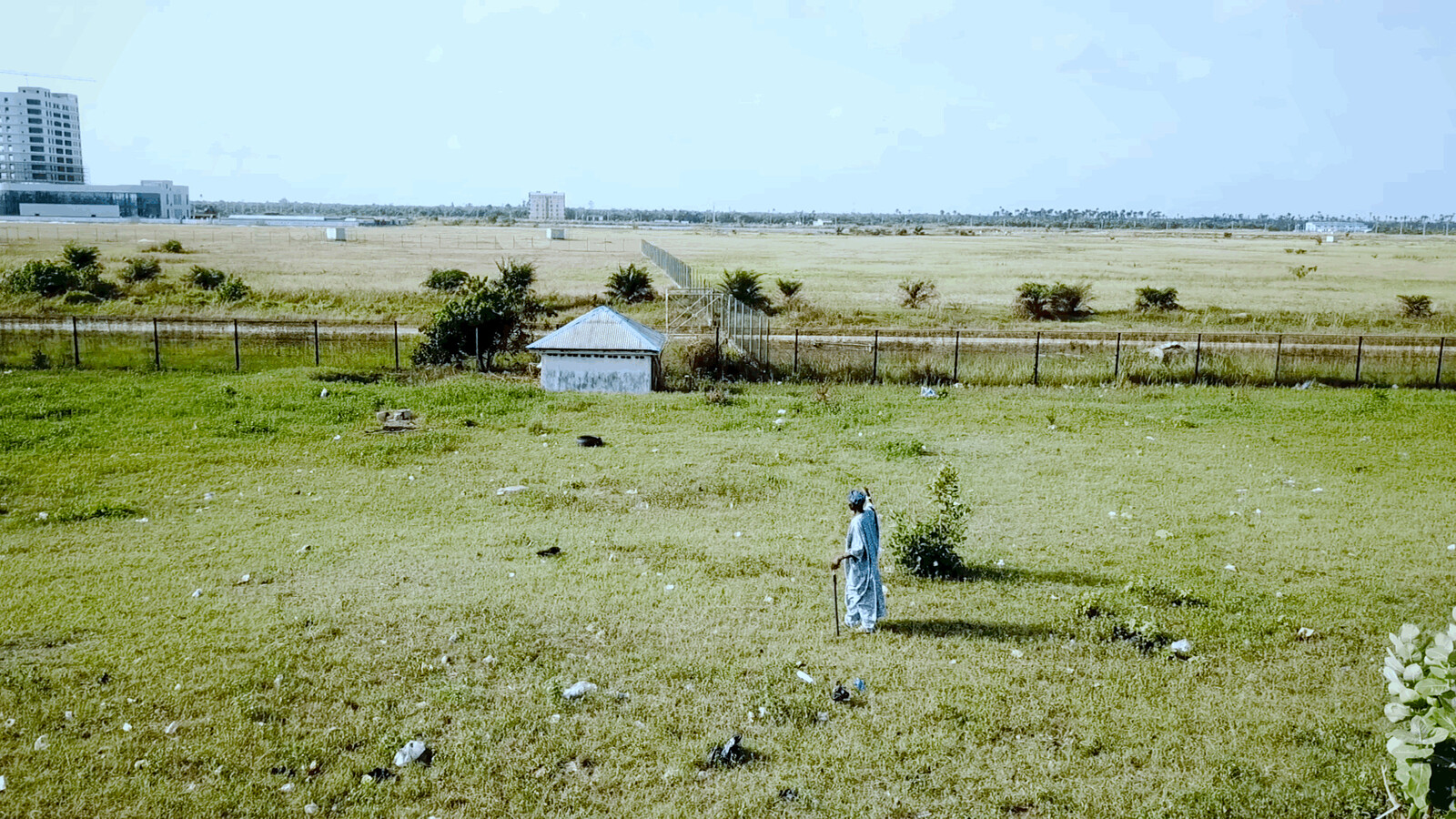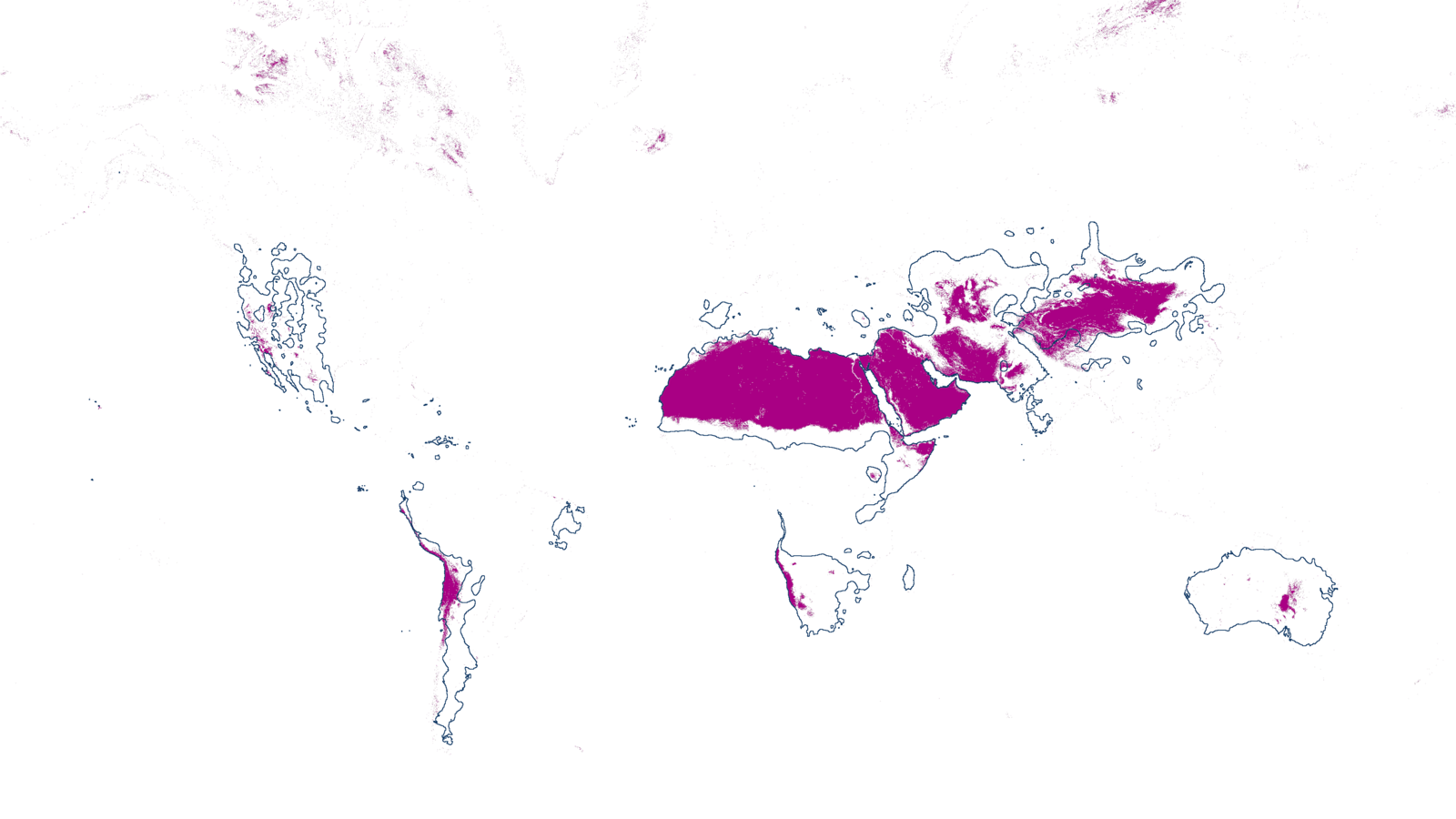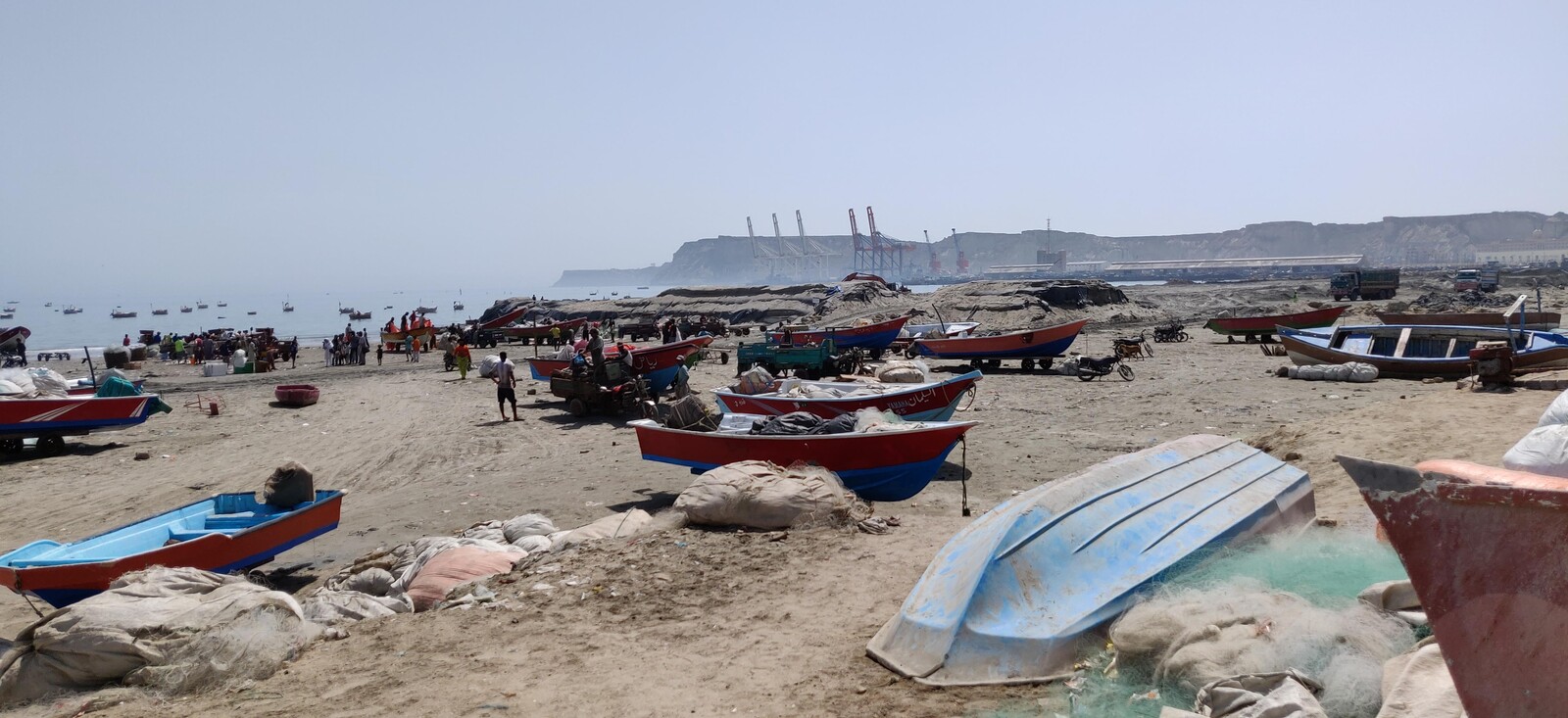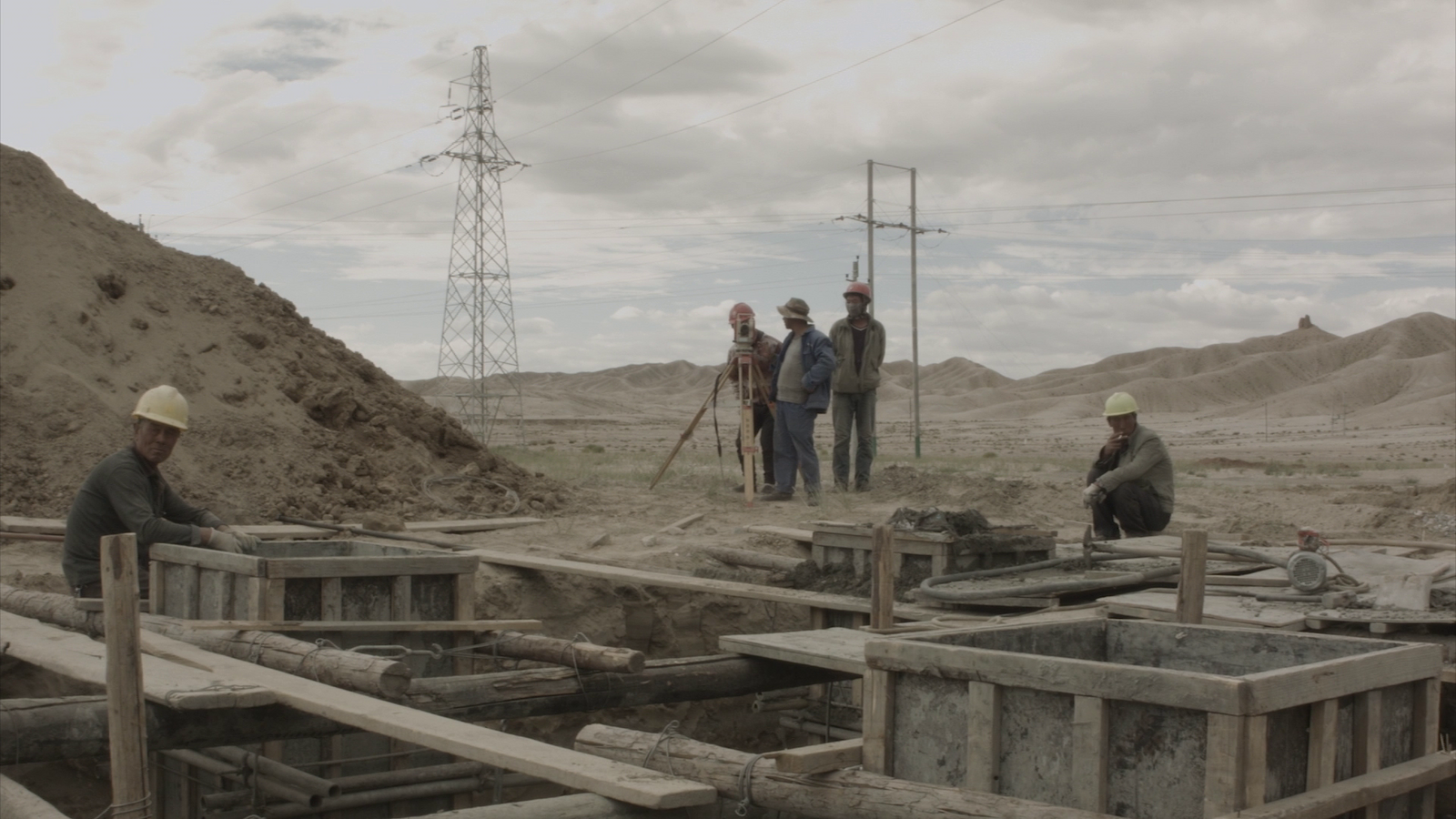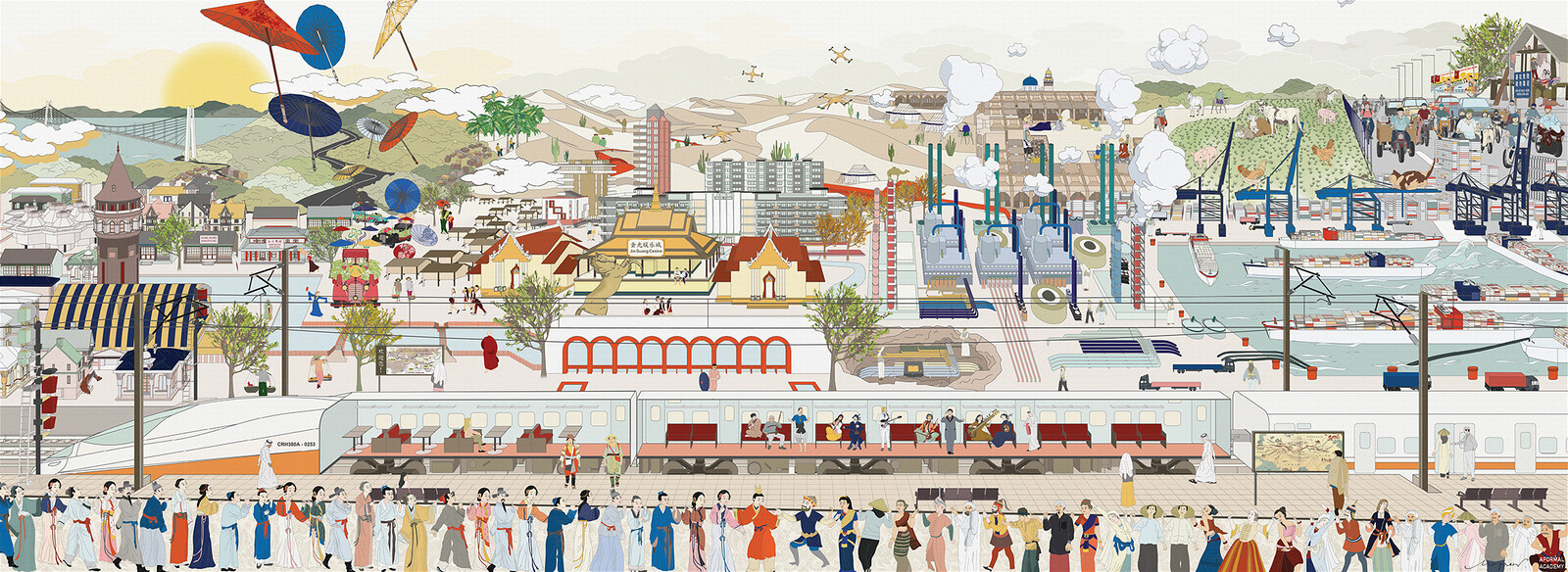The Beinecke Library at Yale houses the Langston Hughes archive. For historians of Central Asia, the African American writer is primarily studied for his trip to the Soviet Union, where he compared the situation of Soviet and American workers through the lens of identity, race, and sexuality. The archive’s holdings from this trip include a folder of photographs and graphic materials from Chirchik, the construction site of an ambitious new electrochemical plant and a series of power stations on the banks of the eponymous river, near Tashkent, in what is today Uzbekistan. Hughes visited the site on November 6, 1932, and was the guest of honor at the first Komsomol meeting of Chirchikstroy, the organization charged with the construction of the new city and industrial facilities.
During his visit, Hughes met a young worker of uncertain ethnic origin, possibly a Tatar or Tajik, named Todzhiev.1 As the writer would later recall, Todzhiev’s “skin was a kind of dirty yellow and his short wiry hair was the same color. American Negroes would call him ‘meriney.’”2 Todzhiev shared the workers’ grandiose plans and uttered five words that Hughes felt most accurately described the essence of the entire Soviet project: “Then there will be light.” With the completion of the power stations in Chirchik, there would be light not only for Uzbekistan, but also for India and China; indeed, for the whole world. “That is why we do not mind giving our labor after hours to build this first building here, these workers’ barracks, and we will give many extra hours to that dam too because when it is done—tell your people in your America—when it is done there will be light! Light to study by and to see and it won’t be dark anymore.”3
One of the documents that Hughes brought back to the United States from Chirchik was a postcard that depicts the location of the future electrochemical plant, two hydroelectric power plants, and a socialist town where Chirchikstroy workers and laborers would live. The ambitions for the socialist construction site are clearly stated in another document in the same archival folder: Niyazbek Station 1 (which would later be renamed as the Komsomol Station) was to be the most powerful power station in Central Asia, and the chemical plant was designed to produce 170,000 tons of ammonium nitrate per year, which would be used as fertilizer to produce ten meters of cotton cloth per year for every citizen of the Soviet Union. The importance of the construction site for military purposes was also indicated; the future plant was the “firstborn” of a powerful heavy industry in the Central Asian republics, and it would play a major role in the defense of the USSR.
Construction began in 1935 and finished in 1940. Stretching over an area forty kilometers in length, the scale of Chirchik exceeded that of similar projects of the same time, such as at Magnitogorsk, the Dnipro River, and Belomorkanal. As a result, the project failed to receive sufficient funding or the necessary qualified personnel. Nevertheless, construction would go on for decades, even outlasting the Soviet Union. To date, the Chirchik-Bozsuu cascade of hydroelectric plants consists of twenty stations, with two more scheduled to be finished in the coming years.
Power Plus Electrification
In 1929, Stalin wrote “A Year of Great Change,” an article marking the transition from the 1920s, a decade of revolutionary experiments in economy and culture, to the 1930s, a period of economic centralization and mobilization, as well as of the new artistic doctrine of socialist realism.4 Alexey Paperny narrates this transition through the logic of historic rupture and discontinuity, metaphorically describing the decades as two opposite banks of a river—Culture I and Culture II.5 Similarly, Boris Groys describes the transition through the metaphor of a river’s natural flow.6 Nariman Skakov argues that both of these grand narratives are inaccurate, and suggests an alternative conceptualization: he claims that, instead of a river, one should imagine a dam that directs revolutionary drive to the oriental peripheries of the Soviet republic.7 Skakov’s metaphor should perhaps be taken literally, in that the Soviet system was transformed in the 1930s by the very real process of constructing dams, which led to a new industrialized state following Lenin’s famous formula: “communism is Soviet power plus the electrification of the entire country.”
In the lexicon of the productionists, a group of avant-garde writers and theorists formed in the 1920s around the influential journal LEF, a hydroelectric power plant is an ustanovka (translated literally, “an installation”): a ramified network of elements that organizes the circulation of social and material forces.8 The productionists saw utilitarian and industrial objects not only as installations, but also as artworks. Accordingly, unlike old works of art, which imitate or try to represent and decorate reality, installations rearrange reality and organize information and energy fields within which the engaged spectator—a proletarian, the new Soviet man—is placed. The organization and transmission of energy (whether pure electrical energy or mixed psychophysical energy circulating in a system of things and subjects) is what unites a power plant with the likes of the theatrical stage elements in Vsevolod Meyerhold’s biomechanics, the layout of a magazine poster, or Alexander Rodchenko’s ideal working environment, Workers’ Club (1925).9
When set in motion, the power plant would, as the boss of the Chirchik site Dav Rozit put it, “bring to life” the materials hidden in the soil of the Chirchik Valley: “deposits of fluorspar, arsenic, dumoterite, gold, kaolin clay, bauxite, marble, limestone, wolframite, molybdenum, bismuth,” as well as “the grandiose Almalyk copper body.”10 According to Rozit,
from the new powerful area of socialist industry in the Soviet East, through cotton, vegetable oil, through copper, aluminum, synthetic rubber, will stretch the most direct threads to meet the needs of the broadest masses of workers of our socialist homeland with food, clothing, to the Union’s high-voltage power transmission networks under construction; these threads will stretch beyond and result in automobile, aircraft, and airship construction.11
The first hydrological studies of the Chirchik River valley were conducted before the revolution,12 and the first proposals for the construction of power plants were made in the 1920s, on the basis of research by Ivan Alexandrov, one of the authors of the GOELRO plan to electrify the Soviet Union and the chief engineer of the Dneprostroy hydroelectric station.13 The Council of Labor and Defense officially decided to construct Chirchik on April 28, 1932, based on a plan by Konstantin Drennov, who proposed not just extracting energy but also directing the power of the river to the production of chemical fertilizers through electrolysis.14 Under natural conditions, the combination of nitrogen, oxygen, and water into nitric acid occurs in humid air when lightning strikes. The same conditions can be created artificially with high enough voltage and huge flows of electricity. With Chirchik’s hydroelectric dams and plants, it would thus be possible to “tame lightning.”15
Chirchik was the first place in the Soviet Union where the technology of electrolysis was implemented. To tame lightning, one must extract energy from the river and then return it. This circulation of energy and matter results in valuable mineral fertilizer, which can be used to nourish the earth. Soviet writers of the revolutionary 1920s saw electricity produced by electrolysis as vital to the equal distribution of natural resources among all the inhabitants of the Soviet republic.16 The magical force of electrolysis—replicating a reaction that occurs in nature on an industrial scale—would attend to the needs of an exhausted Soviet population that had survived revolution, civil war, and years of famine. Electrification was not only an achievement of technical progress, but also the conduit of a social ideal.17 Light was not the goal, but the primary means of achieving it.
Marxism Plus Americanism
For a host of Soviet thinkers in the 1920s, the United States and its imagined cultural and ideological system—Americanism—were an ideological reference point and goal. In the same milieu as the productionists and the developers of the nauchnaia organizatsiia truda (the “scientific organization of labor,” a system developed to create ideal working conditions and scientifically describe what work should be like), time management and Taylorism were seen as American ideals that the Soviet system should engage with dialectically to achieve optimal conditions of production.18 Beyond Lenin’s formula for electrification, Nikolai Bukharin—a revolutionary and one of the leaders of the Communist Party, who had previously resided in the United States—also stated the following: “Now we need a psychotype with all the positive qualities of the old Russian intelligentsia in terms of Marxist doctrine, but with American practical acumen. We need Marxism plus Americanism.”19
If rational work and precision in the distribution of effort and time were seen as virtues by both the Soviet Union and the United States, the point of divergence between the two was in the distribution of waste and frugality. As an example of the bourgeois, senseless, spectacular, and wasteful use of electricity in the United States, the productionist Ivan Kushnir refers to “a sheaf of light with the power of four billion normal electric candles” that displays the name of a theater program in the sky over New York City.20 Rather than waste energy, he claimed, socialism in general and the Soviet system in particular should instead work towards a frugal and fair distribution of resources.
However, the exchange between the two countries happened not only at the level of imagination and ideology: people also moved from one country to another. Langston Hughes was one of many people who participated in cultural, scientific, and technological exchange. Some researchers point to the period of the late 1920s and early 1930s as the first détente between the countries.21 American specialists participated in the electrification of the Soviet Union: they took part in the design of the Dnieper Hydroelectric Station (Dneproges) in the Ukrainian SSR, which was only possible to build with American equipment. Hugh Cooper, one of the experts at the Ukrainian construction site, received an invitation from the USSR government in 1926 and was subsequently named chief consulting engineer for the construction of the Dneproges dam, which at the time was one of the biggest in the world. Cooper worked in conjunction with the chief engineer of the site, Ivan Alexandrov, who had earlier developed the plan for Chirchik. On September 7, 1932, Stalin presented the Order of the Red Banner of Labor to six American consultants under Cooper’s direction “for particularly outstanding work at Dneproges” in appreciation of their contribution to the Soviet economy.
While American technologies were necessary for Dneproges, the power stations and electrochemical plant at Chirchikstroy were designed to be built with Soviet-made equipment. To achieve this, a group of specialists from Chirchikstroy, headed by Dav Rozit, went on a trip to Europe and then America to learn more about electrolysis technology and to examine ten facilities that used the electrochemical reaction.22 It was only after this trip that the ambitious goal for Chirchik was formulated: to build the largest electrolyzer in the world and optimize the production of nitric acid.23 As Rozit wrote, “The Chirchik electrochemical plant, more powerful than all the nitrogen plants now existing in the world, should be not only the largest in its scale, but also the most perfect in its apparatus.”24 However, as a result of economic mobilization in the 1930s and latent preparation for war, the United States and the entire Western world ceased to be an ideological benchmark for the Soviet Union. Instead, the West became a rival and adversary to overcome in industrial competition. Electrolysis and nitrates were not just useful for fertilizer, but also for explosives.
War and Mobilization
Discourse around mobilization and preparation for war ran through the whole of the Chirchik project, from the attitude towards nature—which was declared an enemy to be tamed and brought under control—to the transformation of men and women into udarniks—who are supposed to sacrifice themselves for labor. The “wild and swift” Chirchik River, Rozit wrote, “knows no barriers” and “hides millions of kilowatts in its turbulent streams” that can be extracted after the construction of canals and dams. These structures made of iron and concrete would not only guide and control the river, but also prevent “catastrophic” floods.25 According to Rozit,
The construction site has become a staging ground for a harsh and decisive struggle against the wild nature and the unbridled and indomitable elements of the big river. The Chirchik Valley, with its roadlessness, deserted steppe, and ruins of medieval kibitkas, is being transformed anew under the resolute onslaught of the Bolshevik builders.26
Whereas the productionists in the 1920s were concerned with conserving resources and creating ideal conditions for labor, in the 1930s, workers and their bodies became sites of extraction. Workers must forget about optimizing resources and provide all their energy for a more important goal: the development of an infrastructure that would ensure victory in a future world war, which was increasingly seen as an inevitability. Instead of a rational distribution of vital energy, virtuosity and heroic self-sacrifice were encouraged in the name of labor. This transformation of discourse towards competitive struggle can be seen in the pages of Chirchikstroy’s local newspaper, which became a forum for publicly shaming workers who failed to meet targets and who let down their fellow workers: “low believers, whiners, disorganizers, bums, slackers, truants, and plodders.”27
Practically every issue of the newspaper throughout the 1930s projected the sense of a state of emergency: construction teams challenged each other in socialist competition or voluntarily committed themselves to exceeding targets. At the same time, the entire construction site was competing with a military unit nearby. In the 1934 “emergency” issue of Udarnik Chirchikstroya, the image of the military unit successfully fulfilling its obligations was invoked as a way to shame workers on the plant site:
Competing with the workers of “Chirchikstroy,” Red Army artillerymen shot down a moving tank with the second shot from a closed position. Shooting, they remembered the obligation given to them by our workers: “The combat training should be excellent!” How do we, the staff of the largest construction site in Central Asia, respond to the challenge of the fighters? What can we boast of in our socialist competition with them? The results of the second ten-day period show that we have nothing to boast of.28
Despite all of this, the chemical plant was only finished in 1940, and production started with gunpowder, not fertilizer. After the outbreak of World War II, machines and personnel from European areas of the union would be relocated to Chirchik, including the future Uzbekkhimmash (Frunze Plant), which, among other things, produced elements for nuclear weapons.29 A 1958 CIA report claimed that the Chirchik electrochemical plant produced “heavy water,” which was presumably used in nuclear reactors to enrich plutonium and create the first Soviet nuclear weapons.30 The entire area around the chemical plant rapidly turned into a center of the Soviet military-industrial complex, also including a tank school and a military base where exercises would be held on a regular basis.

Pages from a special issue of Ogonyok magazine marking the tenth anniversary of the creationI of the Central Asian republics in 1934.

Pages from a special issue of Ogonyok magazine marking the tenth anniversary of the creationI of the Central Asian republics in 1934.

Pages from a special issue of Ogonyok magazine marking the tenth anniversary of the creationI of the Central Asian republics in 1934.

Pages from a special issue of Ogonyok magazine marking the tenth anniversary of the creationI of the Central Asian republics in 1934.
Pages from a special issue of Ogonyok magazine marking the tenth anniversary of the creationI of the Central Asian republics in 1934.
Cadres Decide Everything
The same postcard of Chirchik from the Langston Hughes Archive at the Beinecke Library is also kept in the Chirchik Local History Museum, which contains a number of photo albums. These albums document not only the labor and lives of Chirchikstroy workers, but also the land, construction materials, and machines; there are whole pages with photographs of soil, cement, and excavators, as well as ones that contain only charts. These photo albums of Chirchikstroy are an archive of images created during the first years of the city’s construction—a kind of index that could be used by Chirchikstroy employees in their communication with external authors and editors or when working on their own publications. The 1934 anniversary issue of Ogonyok, one of the oldest weekly illustrated magazines in Russia, was dedicated to the tenth anniversary of the formation of Soviet republics in Central Asia and uses an image contained in these photo albums. Another photograph is used to illustrate a book by Rozit in 1935, and several photographs present in the Langston Hughes archive in New Haven are also in these albums. In a sense, these photo albums can be seen as the heart of the circulation of Chirchikstroy images. The circulation of these images were a form of socialist propaganda, advocating for the construction of a new Soviet man. Propaganda is not a single message or event, but a flow of images, texts, and messages. In the Soviet system, propaganda was synonymous with enlightenment and had no negative or subversive connotations. It was seen as a complex network of cultural associations and images that reflected, reinforced, and transformed the political, social, and economic system.31 All reality outside of socialist realism—the main cultural doctrine of the 1930s—was, in a sense, a wilderness waiting to be domesticated, read, and interpreted. As Yevgeny Dobrenko puts it, socialist realism as the main propaganda tool of the 1930s was a machine for processing reality into socialism.32
The word “cadre” in Russian has two meanings: it is both a worker and a photograph. In this sense, Stalin’s famous expression “Cadres decide everything” also has a double meaning: the rapid flow of images from Chirchikstroy transforming the consciousness of inhabitants of the Soviet Union and allies around the world was equally as important as the actual flow of human resources and labor, workers, and engineers. That said, people did flock to Chirchik from other parts of the Soviet Union for the construction of the chemical and power plants. At the very beginning, the flow of personnel began from Dneprostroy; in 1933, a group of workers arrived from Ukraine, including the notable Shulamis Zelberstein, who was appointed one of the heads of the construction site.33 But the process moved in the opposite direction as well. Fedor Georgievich Loginov, who had been appointed head of Chirchik after Rozit, was put in charge of rebuilding the station on the Dnieper River in 1945.34
The photo albums contain many portraits of construction managers whose lives were tragically cut short due to the Great Purge (1936–1938). Dav Rozit, the boss of the Chirchik construction site, was shot in 1938 in the village of Kommunarka, near Moscow, together with Faizulla Khodjaev, one of the leaders of the Uzbek SSR who also took part in the construction of Chirchik.35 They were both accused of a right-wing conspiracy allegedly orchestrated by Nikolai Bukharin—the proponent of Americanism with a Marxist face—and of sabotage at the Chirchik construction site. Soon after, the Chirchikstroy newspaper published incriminatory articles about Rozit and Khodjaev, and their portraits in the Chirchik Local History Museum were defaced with the inscription “IZ,” presumably the abbreviation for “traitor to the motherland” (izmennik rodiny).

Effaced portraits of the Chirchikstroy workers. Source: Chirchik Local History Museum.

Effaced portraits of the Chirchikstroy workers. Source: Chirchik Local History Museum.

Effaced portraits of the Chirchikstroy workers. Source: Chirchik Local History Museum.
Effaced portraits of the Chirchikstroy workers. Source: Chirchik Local History Museum.
Bird’s Eye View
On the back of Langston Hughes’s postcard from Chirchik, there is an attempt to translate the Russian word perspectivnyi, which appears on the front, into English. The word “perspective” in Russian has several connotations. Spatially, it implies a forward-looking gaze towards the horizon, over which a sense of mastery is held. Temporally, it is linked to expectations of future material gain to be derived from that place. An analogy can be found in the use of the word “prospect” in Western colonial practices.36 Hughes, however, translates this term as “bird’s eye view.” Coincidentally, the lore of the land where Chirchik was built includes the story of a bird.
According to popular legend, when countless Dzungarian invaders began to approach the area from the east in the early eighteenth century, locals fled in panic, abandoning their homes. Yet a man named Töle Biy—who lived exactly where the electrochemical plant and power stations would be built—did not. The chief of the Dzungars ordered him to be brought to court and asked him if he was truly afraid of nothing. Töle Biy answered that he did not want to dismantle his yurt and destroy the nest of a swallow with newborn chicks. This confession so moved the stern Dzungar that he did not harm either him or his relatives. After that, Töle Biy became known as Qaldirg’och Biy, or Biy, the swallow. Later, he inspired the people to fight the Dzungars, and after their expulsion around 1740, he was elected governor of Tashkent. By the end of the nineteenth century, his settlement in Chirchik had become a fortress, which guarded the water outlet to Tashkent through the Bozsu Canal. In 1865, when the Russians took Tashkent, they had to take control of this fortress and cut off the water supply to the city before its inhabitants would surrender.37

“Cable bridge over the Chatkal river in the upper part of Chirchik. 40 kil. higher than the dam – 90 from T.” Source: Langston Hughes Papers, James Weldon Johnson Collection, Yale Collection of American Literature, Beinecke Rare Book and Manuscript Library.

“Foot of mountain. Health resort Chimgan – 90 k. from T. 40 k. higher than dam.” Source: Langston Hughes Papers, James Weldon Johnson Collection, Yale Collection of American Literature, Beinecke Rare Book and Manuscript Library.

“Charvakski Gorge. 70 kil. from Tashkent. 20 kil. higher than Ch.stroy. River Chirchik – 30 meters wide.” Source: Langston Hughes Papers, James Weldon Johnson Collection, Yale Collection of American Literature, Beinecke Rare Book and Manuscript Library.

“General view Chirchik River near village Gazalkent – 15 higher than dam, 65 kil. from Tashkent.” Source: Langston Hughes Papers, James Weldon Johnson Collection, Yale Collection of American Literature, Beinecke Rare Book and Manuscript Library.

“Upper portion of Chatkal, summit of the Greater Chimgan, Part of the Western branches of Tian Shan range dividing USSR from China.” Source: Langston Hughes Papers, James Weldon Johnson Collection, Yale Collection of American Literature, Beinecke Rare Book and Manuscript Library.
“Cable bridge over the Chatkal river in the upper part of Chirchik. 40 kil. higher than the dam – 90 from T.” Source: Langston Hughes Papers, James Weldon Johnson Collection, Yale Collection of American Literature, Beinecke Rare Book and Manuscript Library.
Töle Biy was a political representative of the Kazakh administrative elite in the region. His ethnic identity and his involvement in armed conflict recall the frontier status of this area. This history was still relevant in the 1930s and reflected the ethnic composition of Chirchik.38 It also reflected the territorial delimitation of the new town, which was partially in the Kazakh ASSR, but following the construction of the plant would be incorporated into the Uzbek SSR.39 The rich ethnic composition of Chirchik is complemented by the rich flora and fauna of the region, which was left in critical condition by the construction work on the river. The solidification of the riverbed led to the gradual shallowing of the river and the destruction of tugais, a special ecosystem in Central Asia that was historically home to countless species of plants and animals, including Turan tigers, which were exterminated by the mid-twentieth century. The 1958 CIA report about Chirchik also states that, for a few months in 1958 and 1959, residents watched yellow smoke billow out from the chimneys of the electrochemical combine.40 When the wind carried it to residential areas, people experienced itching and irritation in their eyes, and they often had to leave their apartments until the smoke cleared. According to numerous testimonies by Tashkent residents, this toxic smoke hung over the capital of Uzbekistan for long enough to acquire its own popular name: foxtail.
The history of Chirchik is an ever-continuing history of infrastructure deployment. The initial vision for the site was to kick-start the free circulation of energy and natural resources, binding together the Tashkent region with the rest of the Soviet Union and later the global economy. But the area rapidly turned into a space of inter-imperial competition, as its facilities were tightly connected to the Soviet military–industrial complex. The dream of circulation also has a darker side, in the form of toxicity. The Chirchik River was forced into a process of radical modernization, which brought ecological catastrophe and the loss of local material and immaterial culture and knowledge.41
In this regard, circulation and toxicity might be viewed as a productive addition to, or even a substitute for, the popular dichotomy of modernity and coloniality, which is usually employed to critique the Soviet project of modernization. In the post-Soviet context, decolonization often entails a certain depoliticization, in which criticism of the distant past replaces a thorough analysis of the recent past and the present. Moreover, decolonization is often used as an acceptable euphemism for an ethno-nationalist stance in critical discourse, or as the next iteration of orientalism in cultural and artistic production. However, the most concerning aspect of decolonial optics is how easily the extreme right can appropriate it, when both Soviet modernization and post-Cold War globalization are declared colonial, and capitalism—in combination with ethno-nationalist traditional values—is declared anti-colonial.42
Detoxification can therefore be seen as an analytical term and political project to overcome terminological discrepancies and re-map international networks of solidarity. The detoxification of former socialist construction sites would not only point to the environmental and human sacrifices of the Soviet period, but also extend this criticism to the present day, when these sites are in danger of further depletion in a profit-oriented, privatized, and globalized context. This call for a “detox” also reminds us of the basic necessity of empathy to cure old traumas.
Langston Hughes, Good Morning, Revolution: Uncollected Social Protest Writings (New York: Lawrence Hill, 1973), 93.
As David Chioni Moore argues, Langston Hughes’s Central Asian observations can be seen as a distinct Afro-planetary vision. David Chioni Moore, “Local Color, Global ‘Color’: Langston Hughes, the Black Atlantic, and Soviet Central Asia, 1932,” Research in African Literatures 27, No. 4 (Winter 1996): 49-70.
Hughes, Good Morning, Revolution, 94.
Joseph Stalin, “A Year of Great Change,” Pravda 259 (November 7, 1929), ➝.
Vladimir Paperny, Architecture in the Age of Stalin: Culture Two (Cambridge, UK: Cambridge University Press, 2002).
Boris Groys, The Total Art of Stalinism: Avant-garde, Aesthetic Dictatorship, and Beyond (Princeton: Princeton University Press, 1992).
Nariman Skakov, “Culture one and a half,” in Comintern Aesthetics, eds. Steven S. Lee and Amelia Glaser (Toronto: University of Toronto Press, 2020), 232.
The journal was active throughout the 1920s and included writings by the most influential artists and critics of that time: Viktor Shklovskiy, Sergei Eisenstein, Dziga Vertov, Aleksei Gastev, Sergei Tretyakov, etc. On the use of the term ustanovka, see Alexandra Novozhenova, “‘Luchshie i prekrasneyshie veshhi — eto te, kotorye dvizhutsa ili sluzhat dlya dvizheniya drugih.’ Proizvodstvennichestvo kak energeticheskaya model” (“‘The best and the most beautiful objects are the ones that move or serve the movement of the others.” Productionism as an energetic model,” in Korobka s karandashami (Box With Pencils) (Moscow: V–A–C Press, 2021).
Sasha Novozhenova, “Sotsializm – NOT – Amerikanizm: nauchnaiia organizatsyia truda i rabota Gustava Klutsisa dlia jurnala ‘Vremia’” (“Socialism – NOT – Americanism: Scientific Organization of Labor and Gustav Klutsis’s work for the journal ‘Vremia’”), in Korobka s Karandashami (Box With Pencils) (Moscow: V–A–C Press, 2021), 66.
Dav Rozit, Chirchikstroy (Gosudarstvennoie izdatel’stvo UzSSR, 1935), 5. My translation.
Rozit, Chirchikstroy, 8. My translation.
For instance, pre-revolutionary research on the hydrology of the Chirchik River can be found in The Atlas of Asiatic Russia, published by the Central Administration of Land and Agriculture in 1914.
In 1923, Ivan Aleksandrov finished one of his major books, Orosheniie novuh zemely v Tashkentskom regione (Irrigation of the New Lands in the Tashkent Region), where he describes the features of the main river of the region, Chirchik.
See Chirchik’s history in three parts published as a public history resource, MyTashkent, ➝.
I found this phrase on the website of Rushydro, a Russian corporation that owns the majority of Russian hydroelectric power facilities that were originally built during the Soviet era. Interestingly, the website also features an essay about the history of Chirchikstroy. The website exemplifies a corporate public history initiative with a specific focus on the hydropower facilities’ role during the war, or, as the site authors describe it: “how the dams fought.” “Hydroelectric Power Stations that Tamed Lightning,” JSC RusHydro, ➝.
See Sasha Novozhenova, “Formulae of Energy,” syg.ma, March 1, 2019, ➝.
Novozhenova, “Formulae of Energy.”
Novozhenova, “Sotsializm – NOT – Amerikanizm.”
As cited in Novozhenova, “Sotsializm – NOT – Amerikanizm,” 90.
Novozhenova, “Formulae of Energy.”
Harold Dorn, “Hugh Lincoln Cooper and the First Détente,” Technology and Culture 20, no. 2 (April 1979): 322–347.
Rozit, Chirchikstroy, 14.
For instance, controling the oxygen emitted during the reaction would increase the resistance of the equipment and the entire structure of the plant.
Rozit, Chirchikstroy, 18.
Rozit, Chirchikstroy, 3.
Rozit, Chirchikstroy, 3. My translation.
“V pomoshch partorgu i proforgu Chirchikstoya” (“For the party and union organizers”), Udarnik Chirchikstroya (1934), 14, 19.
“Nash otvet podshefnikam” (“Our Answer to the Wards”), Ekstrennyi vypusk Udarnika Chirchikstroya (Emergency issue of the Chirchikstroy Udarnik), June 18, 1934. My translation.
“Machinery Manufacturing Plant ‘Frunze,’ Chirchik, USSR,” Central Intelligence Agency, Office of Research and Reports, December 31, 1957, ➝.
“Heavy Water Plant: Chirchik Electrochemical Combine, USSR,” Central Intelligence Agency, July 1964, ➝.
Revolutionary longue durée projects like the construction of Magnitogorsk, the establishment of the annual International Women’s Day on March 8, and the myth of the October Revolution were created for the radical transformation of reality and consciousness. See Elizabeth A. Papazian, “Literacy or Legibility: The Trace of Subjectivity in Soviet Socialist Realism,” in The Oxford Handbook of Propaganda Studies, eds. Jonathan Auerbach and Russ Castronovo (Oxford: Oxford University Press, 2013), 68-69.
Evgeny Dobrenko. cited in Papazian, “Literacy or Legibility,” 70.
After completing her work in Chirchik, Zelberstein continued her journey and was sent to the Uglich and Rybinsk hydroelectric power plants. “25 let Rybinskoy i Uglichskoy GES,” in Opyta stroitelstva (Izdatelustvo Energiia, 1967), 207–208.
He was appointed after the station was demolished in 1942, during the Soviet retreat from Ukraine, according to a detailed biography of Loginov, who relocated to Ukraine in 1944 after having led Chirchikstroy in the late 1930s and early 1940s. Aleksandre Rogozin, Loginov i yego vremia (Loginov and His Time) (Volgograd: Volzhskogo instituta stroitelystva i tehnologiy, 2013).
Dav Rozit had initially participated in the Russian Civil War (1917–1922), as commissar of a special department of Latvian riflemen in the 15th Army, and in the bloody suppression of counter-revolutionary uprisings, including those in Kronstadt. His career trajectory from peasant to partisan fighter to chairman of the State Planning Committee of Uzbekistan was largely due to the education he received at the Institute of Red Professorship. Rozit’s short biography is available in Mikhail Pole, Istoriya ‘Latyshskih strelkov’: Ot pervyh marksistov do generalov KGB (The History of “Latvian Riflemen”: From the First Marxist to General of the KGB) (Rodina, 2021).
As Jennifer Raab points out in her essay on individualism and gold mining in California, “Once solely associated with the aerial and with distance, ‘prospect’ moved to the subterranean and to the speculative business of searching for metal.” Jennifer Raab, “The Art of Alchemy: Golden Pictures, or Turning Extractive Capitalism into American Individualism,” in El Dorado: A Reader, ed. Aimé Iglesias Lukin, Tie Jojima, Karen Marta, and Edward J. Sullivan (New York: Americas Society, 2024), 72-81.
The story of the Russian invasion is crucial to local knowledge in Tashkent. The takeover of the Niyazbek Fortress was documented in numerous sources, for instance, Yuri Yuzhakov, Shestnadtsatiletnyaia godovshina vzyatiya Tashkenta (The sixteenth anniversary of the takeover of Tashkent) (Saint Petersburg: Komarov, 1881).
Throughout the 1930s, groups of peasants and workers from Kazakhstan were resettled to the area around Chirchikstroy to provide necessary labor.
Administrative expediency was cited as the reason for the transfer of the entire production area under Tashkent’s control.
“Chirchik Chemical Plants (REF: 50X1-HUM),” Central Intelligence Agency, November 2, 1959, ➝.
This socialist enthusiasm for free and economically rational circulation is comparable to the academic enthusiasm for the idea of circulation as a kind of marker of the global turn in the social sciences and humanities. Stefanie Gänger argues that researchers borrowing the economic term to describe accelerating globalization risk falling for a utopian perception of a globalized world in which objects, people, and ideas simply glide across the world without obstacles or resistance, without violent effects on communities across the planet and the environment. Moreover, Gänger claims that global and transnational historians risk becoming prophets and preachers for globalization, just as national historians served nationalism and early historians of empire served imperialism. Stefanie Gänger, “Circulation: reflections on circularity, entity, and liquidity in the language of global history,” Journal of Global History 12, no. 3 (November 2017): 303–318.
As Miri Davidson points out in her recent essay, “A globalist, rootless, parasitic, financial capitalism (imagined now as colonial) is separated from a racial, national, industrial capitalism (imagined as self-determining, or even decolonial).” Miri Davidson, “Sea and Earth,” Sidecar (blog), April 4, 2024, ➝.
New Silk Roads is a project by e-flux Architecture in collaboration with the Critical Media Lab at the Basel Academy of Art and Design FHNW and Noema Magazine (2024), and Aformal Academy with the support of Design Trust and Digital Earth (2020).
